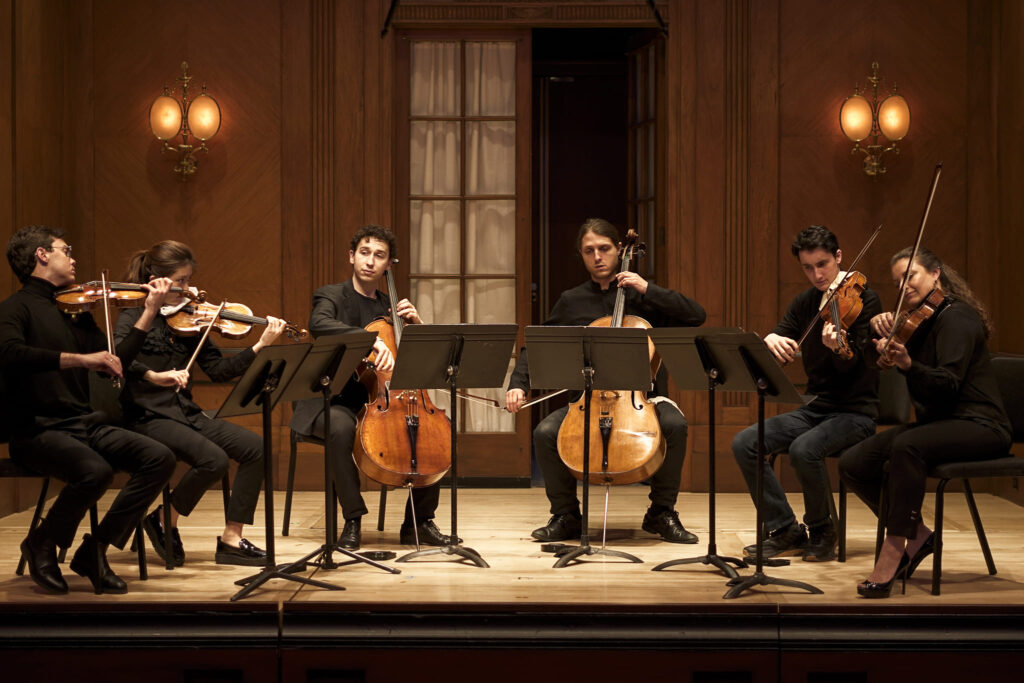Curtis on Tour impresses with music old and new for string sextet

Curtis on Tour, a crack ensemble of string players from the celebrated Curtis Institute of Music in Philadelphia, brought an impressive program to the Chamber Music Society of Fort Worth’s concert series Saturday afternoon at the Modern Art Museum. Curtis violin professor Benjamin Beilman led the string sextet—two violins, two violas, and two cellos. In addition to Beilman, three players are Curtis graduates, and two are current students.
The concert’s first half featured three single-movement works, followed after intermission by one of Johannes Brahms’s string sextets. The Curtis lineup showcased a group of sensitive chamber musicians whose communication and cohesive identity belied the fact that they are not regular collaborators in a long-established ensemble. They were well matched and balanced throughout the concert.
Richard Strauss’s Sextet serves as the unconventional introduction to his final opera Capriccio, completed and performed in 1942. Strauss’s late lyrical style is immediately apparent in the work’s warm, sweet sonorities, but while his language is conservative for the 1940s, the piece could not be mistaken for a work from the nineteenth century.
The dramatic middle section featured robust violin and viola solos (by Na Hyun Della Kyun and Emad Zolfaghari, respectively), both deftly performed. Francis Carr’s cello part blossomed, while Kyun’s playing was clean and poised.
The second work was a true oddity, Alban Berg’s Piano Sonata, Op. 1, arranged by Heime Müller for string sextet. The players’ lyricism bolstered Berg’s reputation as the most lyrical of the Second Viennese School composers. The group aptly alternated between buoyant and heavy sonorities. In addition to Müller’s care with timbral variety (including the use of mutes), the arrangement transformed a solo piano idiom by adding and subtracting instrumental lines. Violins or cellos in unison reinforced important themes without being overbearing, while at times one viola or cello remained silent for several measures.
Oliver Herbert nicely articulated his inner cello part, which frequently had its own identity within the shifting textures. The developmental section sometimes splintered into eight lines, which in the homogenous string blend felt more open and brighter than the original piano version, thanks in part to the different timbres that string players traditionally employ.
Alyssa Weinberg’s Illuminating Arches, composed in 2023, was heard in its world premiere. The composer, also a Curtis alumna, explained in a program note how her sextet was inspired by witnessing a late night sky transform to dawn, seen from a rock formation in Utah’s Arches National Park.
Weinberg’s work opened with thin, ethereal sonorities produced by light harmonics and tremolos, leading to spacious colorful clusters. After the harmonies settled above a low C string drone, upward-cascading lines rippled among the various parts, followed by effective high, short ostinatos migrating from the violins to violas.
A special unaccompanied moment near the end of Illuminating Arches was cellist Herbert’s rendering of a rolling arpeggio of harmonics across all four strings. As in the entire program, Beilman played with finesse and a radiant tone. The work is dramatic but predominantly gentle. Rare rough moments in the piece were punctuated by violent snap pizzicatos. The care taken by the group for this work was apparent, producing marvelous ensemble playing.
After intermission, the players took up Brahms’s String Sextet No. 2 in G major, Op. 36. As this melodic work shows, even those who deride Brahms’ meat-and-potatoes orchestral writing usually can’t fail to be smitten by the richness of his chamber music.
In the first movement the violins were especially supple and airy, while the entire group played with aplomb as an ensemble and in the individual parts. Beilman, Herbert, and violist Milena Pajaro-van de Stadt had assured, majestic solos.
The ensemble emphasized the scherzo’s darker tones and varieties of color. The pairs of violins, violas, and cellos took turns percolating in the background (often with pizzicato) and soaring with the main themes. The triple-meter trio section, marked presto giocoso, rollicked.
The slow movement opened with a high string trio of two violins and viola, followed eventually by Carr holding steadfast on the lowest part. The engaging themes that Beilman and Pajaro-van de Stadt shared were outstandingly played, as were the perfectly matched violins.
The graceful lines of the Brahms finale were made transparent throughout the ensemble. While the players’ technique was never overtly on display, each served the group’s superb interpretations. Throughout the program, the Curtis on Tour ensemble played with exquisite balance, intonation, and sensitivity.
The Chamber Music Society of Fort Worth’s next concert takes place March 23. The program includes Mozart’s Duo and Piano Quartet No. 1, Dohnányi’s Serenade, and Wieniawski’s Legende. cmsfw.org
Posted Feb 27, 2024 at 1:12 pm by Claudio Lehmann
Wonderful performances by a very talented group of chamber musicians. Enjoyed especially tha Weinberg piece with its originaliyt and the beautiful Brahms sextet and its outstanding display of brilliance especiallly the first violinist first viola and first cellos.